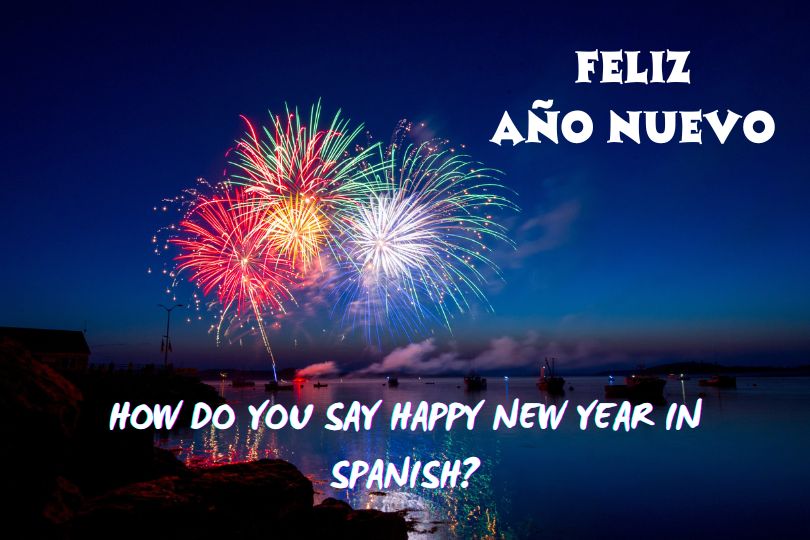How do you say Happy New Year 2024 in Spanish
How do you say Happy New Year 2024 in Spanish? As the calendar turns the page to a new year, the world unites in bidding farewell to the old and welcoming the new with open arms and hearts filled with hope. One of the beautiful aspects of celebrating the New Year is the diversity of languages and cultures that come together to express joy, optimism, and well-wishing for the year ahead. In this article, we’ll explore how to say “Happy New Year 2024” in Spanish, the cultural significance of this greeting, and a glimpse into New Year’s traditions in Spanish-speaking countries.

How to say Happy New Year 2024 in Spanish?
To convey “Happy New Year 2024” in Spanish, you can use the following phrase:
- “Feliz Año Nuevo 2024!” – This is the most straightforward and widely used greeting to wish someone a Happy New Year in Spanish. Here’s a breakdown of the phrase:
- “Feliz” means “happy” or “joyful.”
- “Año” translates to “year.”
- “Nuevo” means “new.”
- “2024” represents the year itself.
So, when you say “Feliz Año Nuevo 2024!” you’re extending warm wishes for a happy and prosperous new year in the year 2024.
Cultural Significance of the Greeting
The greeting “¡Feliz Año Nuevo!” holds immense cultural significance in Spanish-speaking countries and communities around the world. It represents more than just words; it’s a heartfelt expression of goodwill, positivity, and hope for the upcoming year. Here are some key aspects of the cultural significance of this greeting:

- Unity: “¡Feliz Año Nuevo!” is a unifying phrase that transcends borders and brings people together across different Spanish-speaking regions. It is a reminder of our shared humanity and the common desire for happiness and well-being.
- Optimism: The greeting reflects the optimism and positive outlook that comes with the start of a new year. It signifies a fresh beginning and the belief that good things are on the horizon.
- Well-Wishing: When you say “¡Feliz Año Nuevo!” to someone, you are essentially sending them your best wishes for the year ahead. It’s a way of expressing your hope that their life will be filled with happiness, success, and prosperity.
- Tradition: Using this greeting is a tradition deeply rooted in Spanish-speaking cultures. It is exchanged among family members, friends, colleagues, and even strangers during the New Year’s celebration.
- Celebration: New Year’s Eve (Nochevieja) and New Year’s Day (Año Nuevo) are celebrated with great enthusiasm in Spanish-speaking countries. People come together for festive gatherings, parties, and fireworks displays to ring in the new year.
New Year’s Traditions in Spanish-Speaking Countries
In addition to the universal greeting, each Spanish-speaking country often has its own unique customs and traditions to celebrate the New Year. Here are some of the notable New Year’s traditions from various Spanish-speaking regions:
- Eating 12 Grapes in Spain: In Spain, it’s customary to eat 12 grapes at the stroke of midnight, one for each chime of the clock. Each grape represents good luck for one month of the coming year.
- Burning “Año Viejo” in Ecuador: In Ecuador, people create effigies called “Año Viejo” (Old Year) representing the past year’s troubles and regrets. These effigies are burned at midnight to symbolize leaving behind the old year’s negativity and welcoming a fresh start.
- Wearing Red Underwear in Mexico: In Mexico, it is believed that wearing red underwear on New Year’s Eve will bring love and passion in the upcoming year. This tradition is embraced with enthusiasm by many.
- Running with Empty Suitcases in Colombia: Colombians have a unique New Year’s tradition of running around the block with empty suitcases. The belief is that it will lead to a year filled with travel and adventures.
- Making a “Muñeco” in Argentina: In Argentina, people create “muñecos” (dolls or figures) representing the old year, often caricatures of famous people. These muñecos are set on fire at midnight to symbolize leaving behind the past.
- “Las 12 Uvas de la Suerte” in Mexico and Spain: In both Mexico and Spain, people eat 12 grapes at midnight, one for each stroke of the clock, to bring good luck and prosperity for each month of the new year.
Conclusion
“Saying “Happy New Year 2024” in Spanish is a wonderful way to connect with Spanish-speaking friends, family, and acquaintances and share in the global celebration of the New Year. Understanding the cultural significance of this greeting and the rich traditions associated with New Year’s Eve and New Year’s Day in Spanish-speaking countries adds depth to the experience. Whether you’re celebrating in Spain, Mexico, Argentina, or any other Spanish-speaking region, the sentiment remains the same: ¡Feliz Año Nuevo 2024! May the year ahead be filled with happiness, prosperity, and new adventures for all.










